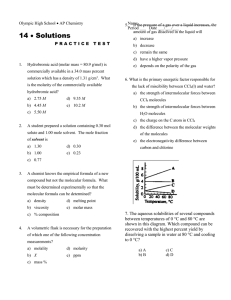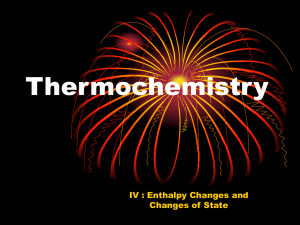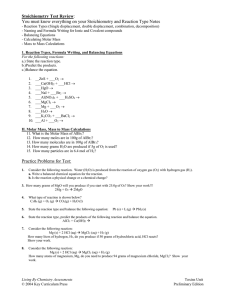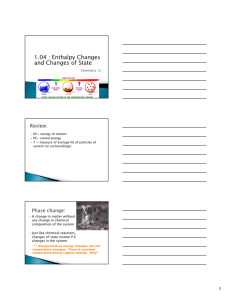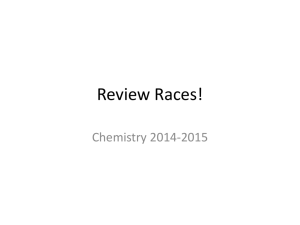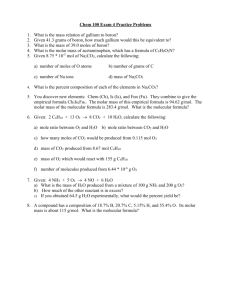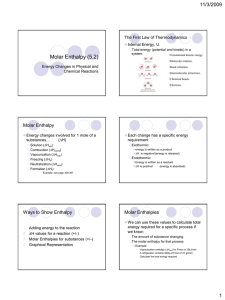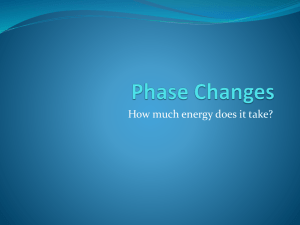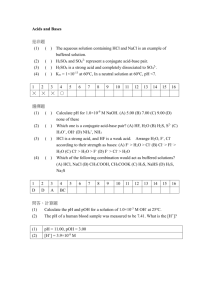Final Exam Review Questions
advertisement
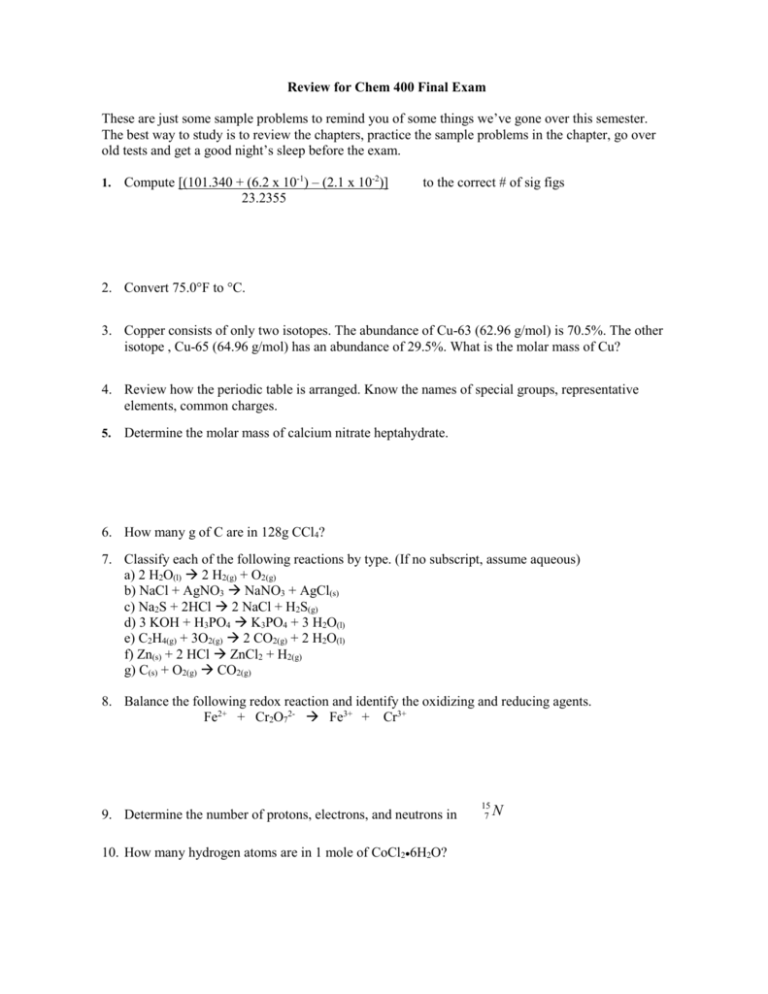
Review for Chem 400 Final Exam These are just some sample problems to remind you of some things we’ve gone over this semester. The best way to study is to review the chapters, practice the sample problems in the chapter, go over old tests and get a good night’s sleep before the exam. 1. Compute [(101.340 + (6.2 x 10-1) – (2.1 x 10-2)] 23.2355 to the correct # of sig figs 2. Convert 75.0F to C. 3. Copper consists of only two isotopes. The abundance of Cu-63 (62.96 g/mol) is 70.5%. The other isotope , Cu-65 (64.96 g/mol) has an abundance of 29.5%. What is the molar mass of Cu? 4. Review how the periodic table is arranged. Know the names of special groups, representative elements, common charges. 5. Determine the molar mass of calcium nitrate heptahydrate. 6. How many g of C are in 128g CCl4? 7. Classify each of the following reactions by type. (If no subscript, assume aqueous) a) 2 H2O(l) 2 H2(g) + O2(g) b) NaCl + AgNO3 NaNO3 + AgCl(s) c) Na2S + 2HCl 2 NaCl + H2S(g) d) 3 KOH + H3PO4 K3PO4 + 3 H2O(l) e) C2H4(g) + 3O2(g) 2 CO2(g) + 2 H2O(l) f) Zn(s) + 2 HCl ZnCl2 + H2(g) g) C(s) + O2(g) CO2(g) 8. Balance the following redox reaction and identify the oxidizing and reducing agents. Fe2+ + Cr2O72- Fe3+ + Cr3+ 9. Determine the number of protons, electrons, and neutrons in 10. How many hydrogen atoms are in 1 mole of CoCl26H2O? 15 7 N 11. What is the percent of zinc by mass in Zn(NO3)2? 12. A hydrocarbon has 38.7% C, 9.74 % H, and also contains O. Determine the molecular formula if the molar mass is 62.1. 13. How many grams of H2(g) can be produced from the following reaction if 1.0 g of Zn is added to 80mL of 0.20 M HCl? Zn + 2 HCl ZnCl2 + H2(g) 14. How many kg of limestone (95.0% CaCO3) are required to neutralize an acid spill consisting of 225 L of 5.00 M H2SO4? (Start by writing a balanced equation.) Balanced Equ: 15. 1.00 g of a gas occupies a volume of 250 mL at 0.95 atm of pressure and 30.0 C. What is its molar mass? 16. How many grams of water at 25 C must be added to 350 mL of tea at 85 C in order for the final temp to be 70 C. (Assume that the specific heat of the tea is the same as water, 1.00 cal/g C) 17. Calculate the H for the reaction 4 NH3(g) + 3 O2(g) 2 N2(g) + 6 H2O(g) given the standard enthalpies of formation of NH3 = -46 kJ/mol and H2O = -242 kJ/mol 18. Is the previous reaction endothermic or exothermic? 19. Calculate the energy of a photon whose wavelength is 350 nm. Plank’s const = 6.626 x 10-34 J sec; speed of light = 2.997 x 108 m/sec 20. How many different spectral lines can be produced from a series of electrons if the excited starting state for all of them is level 4? 21. Which set of quantum numbers are allowed? a) 2,0,0, ½ b) 3,3,2,- ½ c) 4,1,0, ½ d) 1,2,1, ½ e) 3,2,-3, ½ 22. What is the electron configuration (long and short form) for Pb? 23. What are the shapes of s, p, and d orbitals? 24. Compare the atomic radii of a) Be, Mg, Sr, Ba, and Ca b) Be, C, O, Li, F 25. Compare the ionic radii of Mg2+, Al3+, O2-, N3-, Na+ 26. Draw the Lewis dot structure for the nitrate ion and tell how many resonance structures would be possible, and determine the bond order for the N-O bond. 27. Determine if each molecule is polar or nonpolar: HF, NO, CHCl3, H2S, CS2, CCl4. 28. What is the pH of a 0.050 M solution of HCl if complete dissociation is assumed? 29. Which geometric arrangement (both electronic and molecular) corresponds to 3 single bonds and 2 nonbonding pairs of electrons? 30. If 112.0 g of sucrose (mm = 342 g/m) is added to 500g water, what is the boiling point of solution? The boiling point elevation constant for water is 0.51 C/m.

